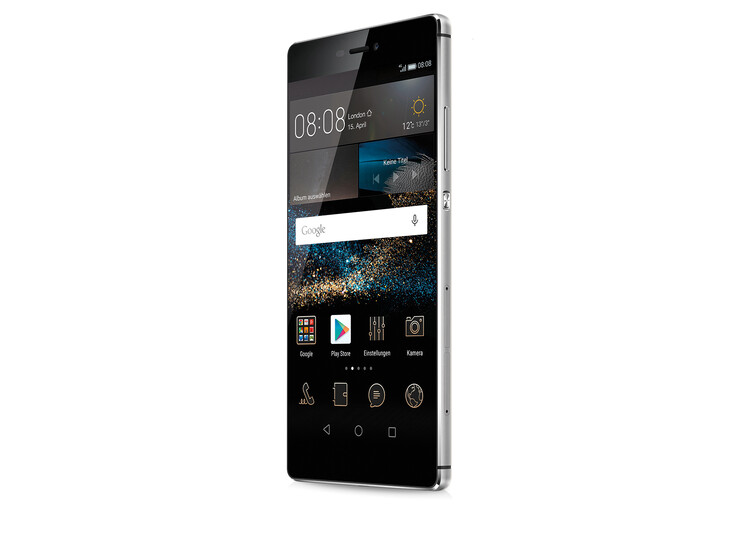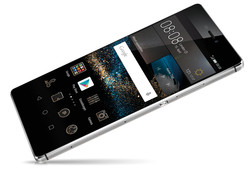Huawei P8 Smartphone First Impressions

For the original German preview, see here.
According to the spec sheet, Huawei's P8 does not have as much to offer as its big high-end rivals from Samsung, Apple, Sony or LG. It primarily seems to be the Kirin 930 processor that is relatively slow compared with other top-of-the-line devices.
However, the looks feature a premium design, and high-quality materials are utilized. The new camera and stronger battery also make a good first impression. The P8 will be available in both a mainstream and premium version. While the former relies on the Kirin 930 and has 16 GB of flash memory, the stronger model sports 64 GB of ROM and the somewhat faster Kirin 935. We are testing the lower-priced model for 499 Euros (~$542). Buyers who want a bit more will have to pony up an additional 100 Euros (~$108).
First Impressions
Huawei's P8 is only slightly bigger than the former Ascend P7. Its height has even been reduced slightly and is now just 6.4 millimeters. Thus, it is the thinnest smartphone among the premium devices and is even slimmer than Samsung's Galaxy S6 Edge (7.0 mm) or the iPhone 6 (7.1 mm). Both contenders are a bit thicker when the protruding camera is counted to their height. The P8 does not have this problem because its camera closes flush with the casing. The review sample is also really pleasant to hold, and it is quite light at 144 grams.
In terms of communication configuration, there will be different versions available with dual and single SIM LTE. Regardless of the version, only LTE Cat. 4 will be installed although the Kirin 930 would support the Cat. 6 version. The P8 also lags behind its contenders in Wi-Fi. The IEEE 802.11 b/g/n standards are supported, and thus the smartphone only transmits in the 2.4 GHz band. The 5.0 GHz bandwidth is actually standard in the mid-range now, not to mention ac Wi-Fi. The connectivity is otherwise state-of-the-art and does not give reason for complaint.
The battery in Huawei's P8 is still non-removable, and it is not intended for the user to replace. The storage can be expanded by up to 128 GB via a micro-SD. Buyers who opt for the dual-SIM version will find a combo slot and will have to decide whether it is to be used as a SIM or memory-card slot.
Camera
The megapixel count in Huawei's P8 has not been revised compared with the precursor. It adds up to 13 MP in both devices. However, the new lens can utilize an optical image stabilizer. Furthermore, it has been optimized for taking particularly good shots in low-light conditions. That also functioned quite well until now, and we are surprised about how well the Chinese company's in-house development fares.
Multiple new features, such as the director mode or light painting, supplement that. Both modes are very easy to use. The fact that the real image is displayed on the screen instead of simply replacing the viewfinder is especially noteworthy.
Videos are still recorded in Full HD. Ultra HD or HFR are not supported.
Display
Huawei has also only modified details in the screen. The screen's diagonal has increased slightly to 5.2-inches. The resolution is still 1920x1080 pixels, which equals an aspect ratio of 16:9 and 424 ppi. The reproduced content is thus razor sharp.
Huawei uses an IPS-Neo screen for the first time in the P8, and it is awesome. Although the maximum brightness does not set new standards, the black level is just supreme for an LC screen at only 0.28 cd/m². That makes an astronomical brightness possible, which only AMOLED screens can presently surpass. We remain curious as to how it will fare in the detailed color accuracy test.
| |||||||||||||||||||||||||
Brightness Distribution: 91 %
Center on Battery: 453 cd/m²
Contrast: 1618:1 (Black: 0.28 cd/m²)
ΔE ColorChecker Calman: 4.7 | ∀{0.5-29.43 Ø4.78}
ΔE Greyscale Calman: 5.03 | ∀{0.09-98 Ø5}
72.04% AdobeRGB 1998 (Argyll 1.6.3 3D)
Gamma: 2.27
CCT: 7439 K
| Huawei P8 Mali-T628 MP4, Kirin 930, 16 GB eMMC Flash | Huawei Ascend P7 Mali-450 MP4, Kirin 910T, 16 GB eMMC Flash | Apple iPhone 6 Plus PowerVR GX6450, A8, 64 GB eMMC Flash | LG G3 Adreno 330, 801 MSM8974AC, 16 GB eMMC Flash | OnePlus One Adreno 330, 801 MSM8974AC, 64 GB eMMC Flash | HTC One M9 Adreno 430, 810 MSM8994, 32 GB eMMC Flash | Samsung Galaxy S6 Edge Mali-T760 MP8, Exynos 7420, 32 GB UFS 2.0 Flash | |
|---|---|---|---|---|---|---|---|
| Screen | -36% | -14% | -49% | -34% | -18% | 14% | |
| Brightness middle (cd/m²) | 453 | 464 2% | 519 15% | 417 -8% | 423 -7% | 474 5% | 343 -24% |
| Brightness (cd/m²) | 439 | 470 7% | 496 13% | 395 -10% | 408 -7% | 458 4% | 338 -23% |
| Brightness Distribution (%) | 91 | 92 1% | 90 -1% | 89 -2% | 83 -9% | 85 -7% | 94 3% |
| Black Level * (cd/m²) | 0.28 | 0.92 -229% | 0.62 -121% | 0.96 -243% | 0.54 -93% | 0.4 -43% | |
| Contrast (:1) | 1618 | 504 -69% | 837 -48% | 434 -73% | 783 -52% | 1185 -27% | |
| Colorchecker dE 2000 * | 4.7 | 4.18 11% | 3.67 22% | 5.67 -21% | 5.56 -18% | 6.32 -34% | 2.2 53% |
| Greyscale dE 2000 * | 5.03 | 3.71 26% | 3.78 25% | 5.66 -13% | 7.55 -50% | 6.36 -26% | 2.37 53% |
| Gamma | 2.27 97% | 2.48 89% | 2.42 91% | 2.53 87% | 2.33 94% | 2.43 91% | 2.41 91% |
| CCT | 7439 87% | 6441 101% | 7327 89% | 7741 84% | 7624 85% | 8218 79% | 6425 101% |
| Color Space (Percent of AdobeRGB 1998) (%) | 72.04 | 59 -18% | 58.81 -18% | 87.77 22% |
* ... smaller is better
Performance
Huawei's P8 is powered by the in-house HiSilicon Kirin 930 alongside 3 GB of working memory. The SoC supports the available 64-bit architecture of the preloaded Google Android 5.0 Lollipop and uses an ARM Mali-T628 MP4 for graphics calculations.
The processor offers two quad-cores (4x Cortex A57 and 4x Cortex A53) that are built in 16 nanometers and operate in the big-LITTLE concept. Since it clocks with up to 2.0 GHz, it should be on par with Samsung's Exynos 7420 in the Galaxy S6 Edge or the Snapdragon 810 in One's M9.
| Geekbench 3 | |
| 64 Bit Single-Core Score (sort by value) | |
| Huawei P8 | |
| Samsung Galaxy S6 Edge | |
| HTC One M9 | |
| 64 Bit Multi-Core Score (sort by value) | |
| Huawei P8 | |
| Samsung Galaxy S6 Edge | |
| HTC One M9 | |
| AnTuTu v5 - Total Score (sort by value) | |
| Huawei P8 | |
| LG G3 | |
| OnePlus One | |
| Samsung Galaxy S6 Edge | |
| HTC One M9 | |
| Sony Xperia Z3 | |
| Apple iPhone 6 Plus | |
| GFXBench (DX / GLBenchmark) 2.7 | |
| T-Rex Onscreen (sort by value) | |
| Huawei P8 | |
| Huawei Ascend P7 | |
| LG G3 | |
| OnePlus One | |
| Samsung Galaxy S6 Edge | |
| HTC One M9 | |
| Sony Xperia Z3 | |
| Apple iPhone 6 Plus | |
| Nokia Lumia 930 | |
| 1920x1080 T-Rex Offscreen (sort by value) | |
| Huawei P8 | |
| Huawei Ascend P7 | |
| LG G3 | |
| OnePlus One | |
| Samsung Galaxy S6 Edge | |
| HTC One M9 | |
| Sony Xperia Z3 | |
| Apple iPhone 6 Plus | |
| Nokia Lumia 930 | |
| GFXBench 3.0 | |
| on screen Manhattan Onscreen OGL (sort by value) | |
| Huawei P8 | |
| LG G3 | |
| OnePlus One | |
| Samsung Galaxy S6 Edge | |
| HTC One M9 | |
| Sony Xperia Z3 | |
| Apple iPhone 6 Plus | |
| 1920x1080 1080p Manhattan Offscreen (sort by value) | |
| Huawei P8 | |
| LG G3 | |
| OnePlus One | |
| Samsung Galaxy S6 Edge | |
| HTC One M9 | |
| Sony Xperia Z3 | |
| Apple iPhone 6 Plus | |
| Octane V2 - Total Score (sort by value) | |
| Huawei P8 | |
| Huawei Ascend P7 | |
| LG G3 | |
| LG G3 | |
| Samsung Galaxy S6 Edge | |
| HTC One M9 | |
| Sony Xperia Z3 | |
| Apple iPhone 6 Plus | |
| Nokia Lumia 930 | |
| Sunspider - 1.0 Total Score (sort by value) | |
| Huawei P8 | |
| Huawei Ascend P7 | |
| LG G3 | |
| LG G3 | |
| OnePlus One | |
| Samsung Galaxy S6 Edge | |
| HTC One M9 | |
| Sony Xperia Z3 | |
| Apple iPhone 6 Plus | |
| Nokia Lumia 930 | |
* ... smaller is better
(+) The maximum temperature on the upper side is 35.7 °C / 96 F, compared to the average of 35.2 °C / 95 F, ranging from 21.9 to 247 °C for the class Smartphone.
(+) The bottom heats up to a maximum of 31.3 °C / 88 F, compared to the average of 34 °C / 93 F
(+) In idle usage, the average temperature for the upper side is 29.6 °C / 85 F, compared to the device average of 32.9 °C / 91 F.
Energy Management & Battery Runtime
The power consumption of Huawei's P8 is only marginally higher than that of the precursor. However, the slightly bigger battery should enable identical battery runtimes. Huawei states a runtime of over two days in moderate use.
| Off / Standby | |
| Idle | |
| Load |
|
Key:
min: | |
Preliminary Verdict
Huawei seems to have developed a round product with its P8. The design is attractive, and it is based on a mix of high-quality materials. The high-contrast screen has an outstanding black level. Furthermore, the camera delivers pretty good pictures and is also very fast.
It is nice to see that Huawei maintains virtues like the option of expanding the storage. Only the communication interfaces are a bit meager. We would have wished for LTE Cat. 6 and ac Wi-Fi in a premium-range smartphone.
Huawei's P8 feels like a flagship smartphone, and it also looks like one. Differences only become apparent in the technical details. Although they might even go unnoticed in everyday use, they will prevent the device from reaching the top ranks. Regardless of that, Huawei's P8 offers a first-rate price-performance ratio.













